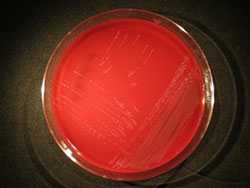Health Care Professionals
Technical Information

Clinical Features
Signs and symptoms of Capnocytophaga infection can vary widely from skin to invasive infections. Symptom onset begins 3 to 5 days after an animal bite, but can range from 1 to 14 days. Symptoms can progress rapidly from mild, localized infection to systemic infection, including sepsis, organ failure, meningitis, and disseminated intravascular coagulation (DIC).
Groups at greater risk of disease include individuals with splenectomies, history of excessive alcohol use, cancer and chronic lung disease—these groups comprise 60% of infections. There are hypotheses that an increased uptake in iron could be a predisposing risk factor for infection. Asplenic patients have a 30 to 60 times greater risk of death from Capnocytophaga infections; these patients can advance to organ failure and death within 24 to 72 hours of onset.
The endogenous human Capnocytophaga species appear to be more often associated with severe immunocompromised patients. Patients who have liver disease or are asplenic have a greater association with zoonotic transmission.
Sequelae
Morbidity can be high, and can include myocardial infarction, renal failure, and amputation due to disseminated intravascular coagulation (DIC).
Even with treatment, mortality can be as high as 30% and death can occur in as little as 24 hours, many times due to complications from shock, DIC, and organ failure.
Surveillance, Incidence, and Trends
Capnocytophaga infections are not nationally notifiable, and thus there is no national estimate of incidence. Infections are rarely reported in the literature.

Laboratory Identification
Capnocytophaga species are fastidious, slow-growing, Gram-negative bacteria. Blood samples are usually used for culture identification. Identification can be difficult; in a study of California specimen submissions to the state Public Health laboratory, only 30% of Capnocytophaga isolates were properly identified by submitting laboratories.
Automated blood culture systems may not identify Capnocytophaga spp. growth due to its slow-growing nature. Some species are very similar, and biochemical analysis may not sufficiently differentiate at the species level.
Other methods of identification include PCR, 16S rRNA gene amplification, and Matrix Assisted Laser Desorption/Ionization Time of Flight (MALDI TOF) mass spectrometry. CDC’s Special Bacteriology Reference Laboratory or your state health department can conduct these tests.
To submit a sample to CDC for Capnocytophaga spp. identification, see laboratory submission information.
All submissions to CDC from within the United States must be approved by your state health department. For contact information, find your health department.
Related Link
About MicrobeNET A CDC Virtual Reference Laboratory
MicrobeNET Request Access
- Page last reviewed: May 12, 2016
- Page last updated: May 12, 2016
- Content source:


 ShareCompartir
ShareCompartir